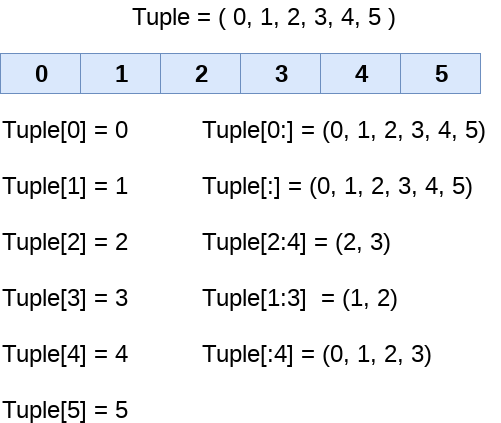Python Tuple
Python Tuple is used to store the sequence of immutable Python objects. The tuple is similar to lists since the value of the items stored in the list can be changed, whereas the tuple is immutable, and the value of the items stored in the tuple cannot be changed.
Creating a tuple
A tuple can be written as the collection of comma-separated (,) values enclosed with the small () brackets. The parentheses are optional but it is good practice to use.
The indexing and slicing
The indexing and slicing in the tuple are similar to lists. The indexing in the tuple starts from 0 and goes to length(tuple) - 1.
The items in the tuple can be accessed by using the index [] operator. Python also allows us to use the colon operator to access multiple items in the tuple.
Consider the following image to understand the indexing and slicing in detail.

Basic
Tuple operations
The operators like concatenation (+), repetition (*), Membership
(in) works in the same way as they work with the list. Consider the following
table for more detail.
Let's say Tuple t = (1, 2, 3, 4, 5) and Tuple t1 = (6, 7, 8, 9)
are declared.
|
Operator |
Description |
Example |
|
Repetition |
The repetition operator enables the tuple elements to be
repeated multiple times. |
T1*2 = (1, 2, 3, 4, 5, 1, 2, 3, 4, 5) |
|
Concatenation |
It
concatenates the tuple mentioned on either side of the operator. |
T1+T2 = (1, 2, 3, 4, 5, 6, 7, 8, 9) |
|
Membership |
It returns true if a particular item exists in the tuple
otherwise false |
print (2 in T1) prints True. |
|
Iteration |
The
for loop is used to iterate over the tuple elements. |
for i in T1: print(i)
Output 12345 |
|
Length |
It is used to get the length of the tuple. |
len(T1) = 5 |
Python Tuple inbuilt functions
|
SN |
Function |
Description |
|
1 |
cmp(tuple1, tuple2) |
It compares two tuples and returns true if tuple1 is greater
than tuple2 otherwise false. |
|
2 |
len(tuple) |
It
calculates the length of the tuple. |
|
3 |
max(tuple) |
It returns the maximum element of the tuple |
|
4 |
min(tuple) |
It
returns the minimum element of the tuple. |
|
5 |
tuple(seq) |
It
converts the specified sequence to the tuple. |
Where use tuple?
Using tuple instead of list is used in the following scenario.
1. Using tuple instead of list gives us a clear idea that tuple
data is constant and must not be changed.
2. Tuple can simulate a dictionary without keys. Consider the
following nested structure, which can be used as a dictionary.
List
vs. Tuple
|
SN |
List |
Tuple |
|
1 |
The literal syntax of list is shown by the []. |
The literal syntax of the tuple is shown by the (). |
|
2 |
The
List is mutable. |
The
tuple is immutable. |
|
3 |
The List has the a variable length. |
The tuple has the fixed length. |
|
4 |
The
list provides more functionality than a tuple. |
The
tuple provides less functionality than the list. |
|
5 |
The list is used in the scenario in which we need to store the
simple collections with no constraints where the value of the items can be
changed. |
The tuple is used in the cases where we need to store the
read-only collections i.e., the value of the items cannot be changed. It can
be used as the key inside the dictionary. |
|
6 |
The
lists are less memory efficient than a tuple. |
The
tuples are more memory efficient because of its immutability. |



0 Comments